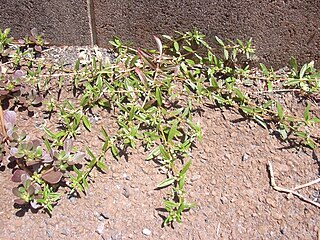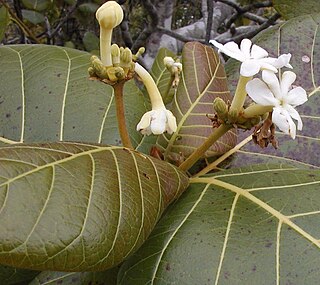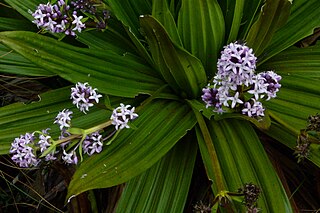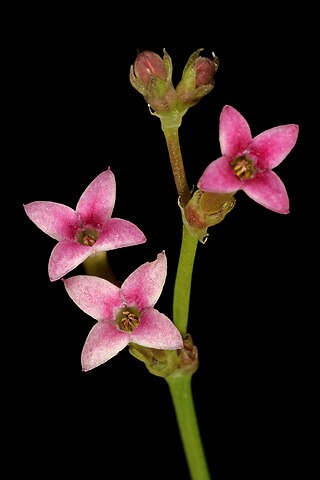
Diederich Franz Leonhard von Schlechtendal was a German botanist. The standard author abbreviation Schltdl. is used to indicate this person as the author when citing a botanical name.
Cuphocarpus is an obsolete genus of flowering plants in the family Araliaceae. Mabberley (2008) treated it as a synonym of Polyscias, but other authors still recognized it at that time. In 2010, in a phylogenetic analysis of DNA sequences, it was shown that Cuphocarpus was biphyletic and embedded in the large genus Polyscias. In an accompanying paper, Polyscias was divided into 11 subgenera, with seven species left incertae sedis.

Oldenlandia is a genus of flowering plants in the family Rubiaceae. It is pantropical in distribution and has about 240 species. The type species for the genus is Oldenlandia corymbosa.

Guettarda is a plant genus in the family Rubiaceae. Most of these plants are known by the common name velvetseed.

Kohautia is a genus of flowering plants in the family Rubiaceae. They are native to tropical areas of Asia, Africa, and Madagascar. Thirty-one species are known. The type species for the genus is Kohautia senegalensis.

Machaonia is a genus of flowering plants in the family Rubiaceae. It has about 32 species. All are indigenous to the neotropics. None has a unique common name. Some species have been called "alfilerillo", a Spanish name for the common and well-known genus Erodium. The type species for Machaonia is Machaonia acuminata.
Platycarpha is a genus of South African plants within the family Asteraceae.
Hedyotis (starviolet) is a genus of flowering plants in the family Rubiaceae. Many species of this genus such as Hedyotis biflora, H. corymbosa and H. diffusa are well known medicinal plants. Hedyotis is native to tropical and subtropical Asia and to islands of the northwest Pacific. It comprises about 115 species. The type species for the genus is Hedyotis fruticosa.
Chione is a monotypic genus of flowering plants in the family Rubiaceae containing the single species Chione venosa. It is native to the neotropics, occurring in most of Mexico, and throughout Central America, the Caribbean, Colombia, Ecuador, and Peru. It is typically a tree growing 10 to 20 meters tall. In harsh habitats, it may be dwarfed and shrubby. It has no known economic use.

Hymenodictyon is a genus of flowering plants in the family Rubiaceae. It has about 30 species. All are native to the Old World. The wood of Hymenodictyon orixense is soft and has limited use, mostly for boxes. The type species for Hymenodictyon is Hymenodictyon orixense.

Adina is a genus of 12 species of flowering plants in the family Rubiaceae. They are shrubs or small trees, native to East Asia and Southeast Asia.

Arcytophyllum is a genus of flowering plants in the family Rubiaceae. The genus contains 18 species, distributed from New Mexico to Bolivia.

Crusea is a genus of angiosperms in the family Rubiaceae. The genus is found in the south-western United States, Mexico, and Central America. A few species are naturalized in Cuba and Puerto Rico.

Deppea is a genus of flowering plants in the family Rubiaceae. The genus is found in Mexico, Central America and from Brazil to northeastern Argentina.

Hedyotis verticillaris is a plant belonging to the family Rubiaceae that is endemic to the higher altitude grasslands of the Nilgiris in southern India. Unlike many others members of the genus the stems of this species are underground and the leaves appear close to the ground forming rosettes and usually hold some water at the centre of the whorl of leaves. The flowers are produced on a stalk.

Ardisia escallonioides, the Island marlberry, is a plant species native to the West Indies and neighboring areas. It has been reported from Barbados, Bermuda, the Dominican Republic, Cuba, Mexico, Belize, Guatemala and Florida.

Wilhelmsia is a monotypic genus of plants in the family Caryophyllaceae. It contains only one species, Wilhelmsia physodes, native to Alaska, northern Canada, and Russia.

Cordylostigma is a genus in the Rubiaceae. The name was coined in 2010 to contain 9 species formerly belonging to the related genus Kohautia. The nine species are native to tropical and southern Africa from Guinea to Somalia to South Africa, as well as Madagascar, Comoros, and Réunion.

Spermacoceae is a tribe of flowering plants in the family Rubiaceae and contains about 1346 species in 57 genera. Its representatives are found in the tropics and subtropics.
Birgitta Bremer, Swedish botanist and academic, is professor at Stockholm University, and director of the Bergius Botanic Garden.
















